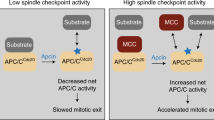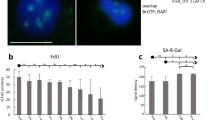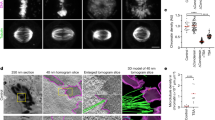Abstract
Studies using living cells1,2 and experimental manipulation of permeabilized mitotic cells3,4 demonstrate that the movement of anaphase chromosomes consists of two physiologically distinct events: chromosome movement to the spindle poles (anaphase A) and separation of the poles via spindle elongation (anaphase B). Shortening of kinetochore-attached microtubules is associated with anaphase A and rearrangement and lengthening of the polar microtubules, especially those found in the spindle midzone, with anaphase B5,6. It has been suggested that interactions between microtubules, mediated by dynein-like cross-bridges similar to those found in flagella, may be the mechanochemical system responsible for anaphases A and B7,8. Recently Bouchard et al.9 have demonstrated that erythro-9-[3-(2-hydroxynonyl)]adenine (EHNA), a protein carboxyl-methylation inhibitor, is a specific inhibitor of flagellar beat and dynein ATPase activity. I have now investigated the possibility that dynein-like ATPases have a role in anaphase by adding EHNA to permeabilized cell models in conditions compatible with maintenance of anaphases A and B after lysis3,4.I find that EHNA blocks anaphase B but not anaphase A. These results are consistent with the involvement of a dynein-like ATPase in spindle elongation.
This is a preview of subscription content, access via your institution
Access options
Subscribe to this journal
Receive 51 print issues and online access
$199.00 per year
only $3.90 per issue
Buy this article
- Purchase on Springer Link
- Instant access to full article PDF
Prices may be subject to local taxes which are calculated during checkout
Similar content being viewed by others
References
Ris, H. Biol. Bull. 96, 90–106 (1949).
Inoué, S. & Ritter, H. in Molecules and Cell Movement (eds Inoué, S. & Stephens, R. E.) 3–30 (Raven, New York, 1975).
Cande, W. Z., McDonald, K. & Meeusen, R. L. J. Cell Biol. 88, 618–629 (1981).
Cande, W. Z. Cell (in the press).
Fuge, H. Int. Rev. Cytol., Suppl. 6, 1–58 (1977).
McDonald, K., Pickett-Heaps, J. D., McIntosh, J. R. & Tippet, D. H. J. Cell Biol. 74, 377–388 (1977).
McIntosh, J. R., Hepler, P. K. & van Wie, D. G. Nature 224, 659–663 (1969).
Margolis, R. L., Wilson, L. & Kiefer, B. I. Nature 272, 450–452 (1978).
Bouchard, P., Penningroth, S. M., Cheung, A., Gagnon, C. & Bardin, C. W. Proc. natn. Acad. Sci. U.S.A. 78, 1035–1036 (1981).
Berthelsen, S. & Pettinger, W. A. Life Sci. 21, 595–606 (1977).
O'Dea, R. F., Viveros, O. H., Diliberto, E. J. Jr Biochem. Pharmac. 30, 1163–1168 (1981).
Forer, A. in Nuclear Division in the Fungi (ed. Heath, I. B.) 21–68 (Academic, New York, 1978).
Penningroth, S. M., Cheung, A., Bouchard, P., Gagnon, C. & Bardin, C. W. Biochem. biophys. Res. Commun. (in the press).
Gaskins, F. & Cantor, C. R. J. molec. Biol. 89, 737–758 (1974).
Author information
Authors and Affiliations
Rights and permissions
About this article
Cite this article
Cande, W. Inhibition of spindle elongation in permeabilized mitotic cells by erythro-9-[3-(2-hydroxynonyl)] adenine. Nature 295, 700–701 (1982). https://doi.org/10.1038/295700a0
Received:
Accepted:
Issue Date:
DOI: https://doi.org/10.1038/295700a0
This article is cited by
-
NuMA phosphorylation by CDK1 couples mitotic progression with cortical dynein function
The EMBO Journal (2013)
-
The perpetual movements of anaphase
Cellular and Molecular Life Sciences (2010)
-
Non-kinetochore transport phenomena, microtubule ? chromosome associations, and force transmission in nuclear division
Protoplasma (1990)
-
Microtubule-associated protein 1C from brain is a two-headed cytosolic dynein
Nature (1988)
-
In vivo effects of ortho-vanadate on spindle structure and dynamics of locust spermatocytes I
Chromosoma (1986)
Comments
By submitting a comment you agree to abide by our Terms and Community Guidelines. If you find something abusive or that does not comply with our terms or guidelines please flag it as inappropriate.



